
Cutler Bay is an incorporated town in Miami-Dade County, Florida established in 2005, with a population of approximately 45,425 as of 2020. With 45,425 people, Cutler Bay is in 9th place of the top 10 most populous municipalities of the 34 municipalities that make up Miami's urban core, it is the 33rd most populous municipality out of the 163 municipalities that up Miami Metropolitan Area and Cutler Bay is also the 88th most populated city in the state of Florida out of 919 cities.

Goulds is a census-designated place (CDP) in Miami-Dade County, within the U.S. state of Florida. The area was originally populated as the result of a stop on the Florida East Coast Railroad. The railroad depot was located near the current Southwest 224th Street. The community was named after its operator, Lyman Gould, who cut trees for railroad ties. As of the 2009 census, the population stood at 10,103.

Homestead is a city within Miami-Dade County in the U.S. state of Florida, between Biscayne National Park to the east and Everglades National Park to the west. Homestead is primarily a Miami suburb and a major agricultural area. It is a principal city of the Miami metropolitan area, which was home to an estimated 6,012,331 people at the 2015 census.

Key Biscayne is an island town in Miami-Dade County, Florida. The population was 12,344 at the 2010 census.
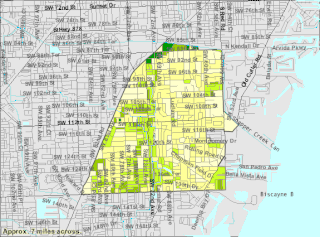
Pinecrest is a suburban village in Miami-Dade County, Florida, United States of America. The 2010 U.S. census recorded a population of 18,223; as of 2019, this has increased by over five percent to an estimated 19,155.
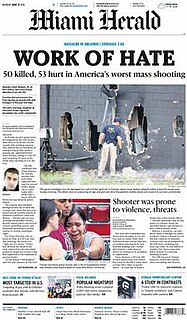
The Miami Herald is an American daily newspaper owned by the McClatchy Company and headquartered in Doral, Florida, a city in western Miami-Dade County and the Miami metropolitan area, several miles west of Downtown Miami. Founded in 1903, it is the fifth largest newspaper in Florida, serving Miami-Dade, Broward, and Monroe Counties. It once circulated throughout all of Florida, Latin America and the Caribbean. The Miami Herald has been awarded 22 Pulitzer Prizes since its 1903 founding.

The Florida East Coast Railway is a Class II railroad operating in the U.S. state of Florida, currently owned by Grupo México.

Palmetto Bay is a suburban incorporated village in Miami-Dade County, Florida, United States. The population was 23,410 during the 2010 US census.
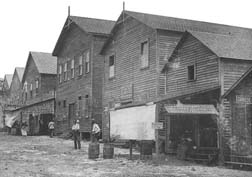
Thousands of years before Europeans arrived, a large portion of south east Florida, including the area where Miami, Florida exists today, was inhabited by Tequestas. The Tequesta Native American tribe, at the time of first European contact, occupied an area along the southeastern Atlantic coast of Florida. They had infrequent contact with Europeans and had largely migrated by the middle of the 18th century. Miami is named after the Mayaimi, a Native American tribe that lived around Lake Okeechobee until the 17th or 18th century.

Charles Deering Estate was the Florida home of Charles Deering until 1927 when he died at the estate.

The Royal Poinciana Hotel was a Gilded Age hotel in Palm Beach, Florida, United States. Developed by Standard Oil founder Henry Flagler and approximately 1,000 workers, the hotel opened on February 11, 1894. As Flagler's first structure in South Florida, the Royal Poinciana Hotel played a significant role in the region's history, transforming the previously desolate area into a winter tourist destination and accelerating the development of Palm Beach and West Palm Beach. Two months later, Flagler's Florida East Coast Railway reached West Palm Beach, while a railroad bridge built across the Lake Worth Lagoon in 1895 allowed guests direct access to the hotel. In 1896, Flagler opened a second hotel nearby, The Breakers. The success of both hotels led to expansions of the Royal Poinciana Hotel in 1899 and 1901. By then, the building had reportedly become both the largest hotel and largest wooden structure in the world at the time.
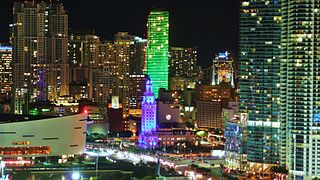
Downtown Miami is the urban city center of Miami, Florida. The city's greater downtown region consists of the Central Business District, Brickell, the Historic District, Government Center, the Arts & Entertainment District, and Park West. It is divided by the Miami River and is bordered by Midtown Miami's Edgewater and Wynwood sections to its north, Biscayne Bay to its east, the Health District and Overtown to its west, and Coconut Grove to its south.
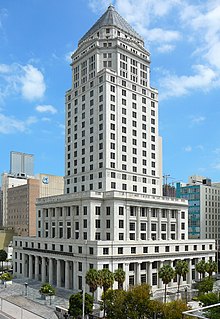
The Miami-Dade County Courthouse, formerly known as the Dade County Courthouse, is a historic courthouse and skyscraper located at 73 West Flagler Street in Miami, Florida. Constructed over four years (1925–28), it was added to the U.S. National Register of Historic Places on January 4, 1989. The building is 361 feet tall with 28 floors. When it was built, it was the tallest building in both the city of Miami and state of Florida.

Redland, long known also as the Redlands or the Redland, is a historic unincorporated community and agricultural area in Miami-Dade County, Florida, located about 20 miles (32 km) southwest of downtown Miami and just northwest of Homestead, Florida. It is unique in that it constitutes a large farming belt directly adjoining what is now the seventh most populous major metropolitan area in the United States. Named for the pockets of red clay that cover a layer of oolitic limestone, Redland produces a variety of tropical fruits, many of which do not grow elsewhere in the continental United States. The area also contains a large concentration of ornamental nurseries. The landscape is dotted with u-pick'em fields, coral rock (oolite) walls, and the original clapboard homes of early settlers and other historic early twentieth century structures.
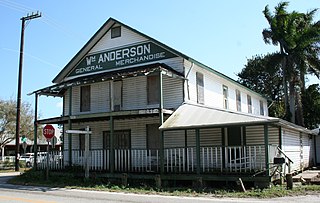
The William Anderson General Merchandise Store is a historic site in Redland, Florida, United States. Built in 1911 by William “Popp” Anderson, who worked for railroad magnate Henry Flagler, the wood-frame structure is located at 15700 Southwest 232nd Street. It served as a general store for the thriving Redlands agricultural community until the 1930s, when it was converted into apartments. Condemned in 1975, it was granted a reprieve for rehabilitation, and was eventually converted into the successful Harvest House restaurant. After being ravaged by Hurricane Andrew in 1992, the building was partially restored, although it has remained vacant since.

The effects of Hurricane Wilma in Florida resulted in the storm becoming the third-costliest tropical cyclone in Florida history. Wilma developed in the Caribbean Sea just southwest of Jamaica on October 15 from a large area of disturbed weather. After reaching tropical storm intensity on October 17 and then hurricane status on October 18, the system explosively deepened, peaking as the strongest tropical cyclone ever recorded in the Atlantic basin. Wilma then slowly weakened while trekking to the northwest and fell to Category 4 intensity by the time it struck the Yucatán Peninsula on October 22. Thereafter, a strong cold front swept the storm northeastward into Florida on October 24, with landfall occurring near Cape Romano as a Category 3 hurricane with winds of 120 mph (190 km/h). Wilma continued rapidly northeastward into the Atlantic Ocean and became extratropical on October 26.

Government Center is a district in the western portion of downtown Miami, Florida bound roughly by I-95 and West (NW/SW) 3rd Avenue to the west, South (SW/SE) 1st Street to the south, North (NE/NW) 5th Street to the north, and East (NE/SE) 1st Avenue to the east.
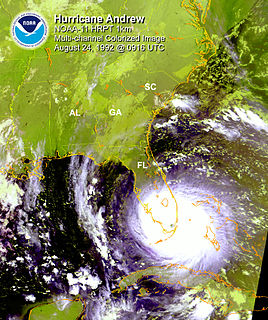
The effects of Hurricane Andrew in Florida proved to be at the time the costliest disaster in the state's history, as well as the then-costliest on record in the United States. Hurricane Andrew formed from a tropical wave on August 16, 1992 in the tropical Atlantic Ocean. It moved west-northwest and remained weak for several days due to strong wind shear. However, after curving westward on August 22, the storm rapidly intensified to reach peak winds of 175 mph (280 km/h). Following its passage through The Bahamas, Andrew made landfall near Homestead, Florida as a Category 5 hurricane on August 24. Eventually, Andrew struck southern Louisiana before it dissipated over the eastern United States on August 28.

Hurricane Andrew was a very powerful and destructive Category 5 Atlantic hurricane that struck the Bahamas, Florida, and Louisiana in August 1992. It is the most destructive hurricane to ever hit Florida in terms of structures damaged or destroyed, and remained the costliest in financial terms until Hurricane Irma surpassed it 25 years later. Andrew was also the strongest landfalling hurricane in the United States in decades and the costliest hurricane to strike anywhere in the country, until it was surpassed by Katrina in 2005. In addition, Andrew is one of only four tropical cyclones to make landfall in the continental United States as a Category 5, alongside the 1935 Labor Day hurricane, 1969's Camille, and 2018's Michael. While the storm also caused major damage in the Bahamas and Louisiana, the greatest impact was felt in South Florida, where the storm made landfall as a Category 5 hurricane, with 1-minute sustained wind speeds as high as 165 mph (265 km/h) and a gust as high as 174 mph (280 km/h). Passing directly through the city of Homestead in Dade County, the hurricane stripped many homes of all but their concrete foundations. In total, Andrew destroyed more than 63,500 houses, damaged more than 124,000 others, caused $27.3 billion in damage, and left 65 people dead.

The Central Business District (CBD) of Miami is the historic central business district and city center of what has become Greater Downtown Miami in Miami, Florida. Over 92,000 people work in Miami's Central Business District.




















